Is Suryanamaskar Good for Weight Loss?

Suryanamaskar is a popular and age-old yoga pose linked to weight loss. Although weight changes are gradual, the effectiveness of Suryanamaskar for weight loss has been proven to be true.
According to Femina India, one set of Suryanamaskar burns around 13.90 calories. So, 12 sets of Suryanamaskar will help you lose around 416 calories over time.
To know how it helps and how to do it, check out the rest of the article!

Table of Contents

Is Suryanamaskar Good for Weight Loss?
Yes, Suryanamaskar, a traditional yoga posture, does help one lose weight. Repeating repetitive motions that involve different muscle groups inside the body increases energy expenditure per time. It also accelerates metabolism and results in gradual weight reduction when done on a regular basis.
When you include Suryanamaskar into your daily routine, you can also be more flexible and fit overall. It is comprehensive because it addresses both physical and mental wellness, hence making it suitable for a weight loss program.
What Type of Fats Can be Reduced Through Suryanamaskar?
Suryanamaskar's impact on fat loss is shown through its numerous health and fitness benefits. Knowing these fat types helps us comprehend why integrating Suryanamaskar into balanced living results in optimal outcomes.
- Subcutaneous Fat: The fat you can feel if you pinch it under your skin. You will look thinner if this fat is burnt with the help of Suryanamaskar.
- Visceral Fat: This type of fat surrounds the organs within the human body and is related to health problems. Regular practice of Suryanamaskar may assist in lessening visceral fats, improving general health conditions.
- Triglycerides: These are types of fats found in your blood vessels. Combining a healthy lifestyle with Suryanamaskar helps to decrease triglyceride levels which further lowers chances for heart attack among people.
Different Poses of Suryanamaskar for Weight Loss and How to Do Them?
There are 4 types of Suryanamaskar poses. These are:
Hatha Surya Namaskar
Sivananda Surya Namaskar
Ashtanga Suryanamaskar Type A and B
Iyengar Surya Namaskar
Below, we will discuss the Suryanamaskar poses for weight loss, including the most popular one, the ancient Hatha version. However, we will also list the different poses required for other versions of Surya Namaskar.
So, here’s how to do Suryanamaskar for weight loss with the Hatha version!
Hatha Surya Namaskar
Hatha Suryanamaskar is the most ancient form of Sun Salutation. It is performed slowly over longer periods than other forms of Surya Namaskar. Hence, it is considered to be among the easiest Suryanamaskar poses for first-time yoga practitioners.
1. Pranamasana (Prayer Pose)
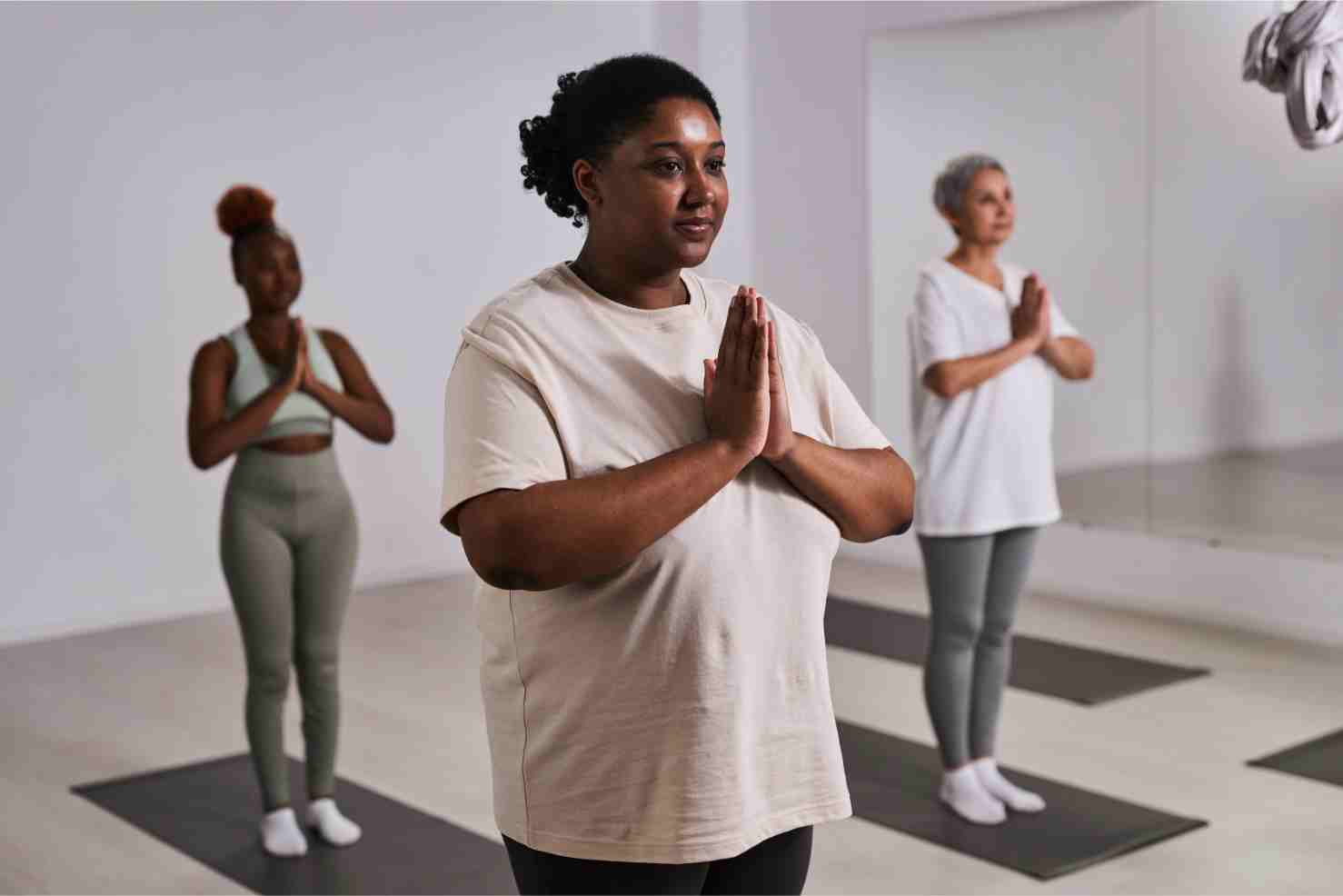
Here’s how to do the first sun salutation pose for weight loss:
Step 1: Stand upright on your yoga mat. Shoulders should be straight and hands by your side.
Step 2: Inhale and lift both of your hands upwards.
Step 3: Exhale and bring your hands together in a namaskar mudra.
Keep your back straight at all times to prevent excess pressure on the lower back.
2. Hasta Uttanasana (Raised Arms Pose)
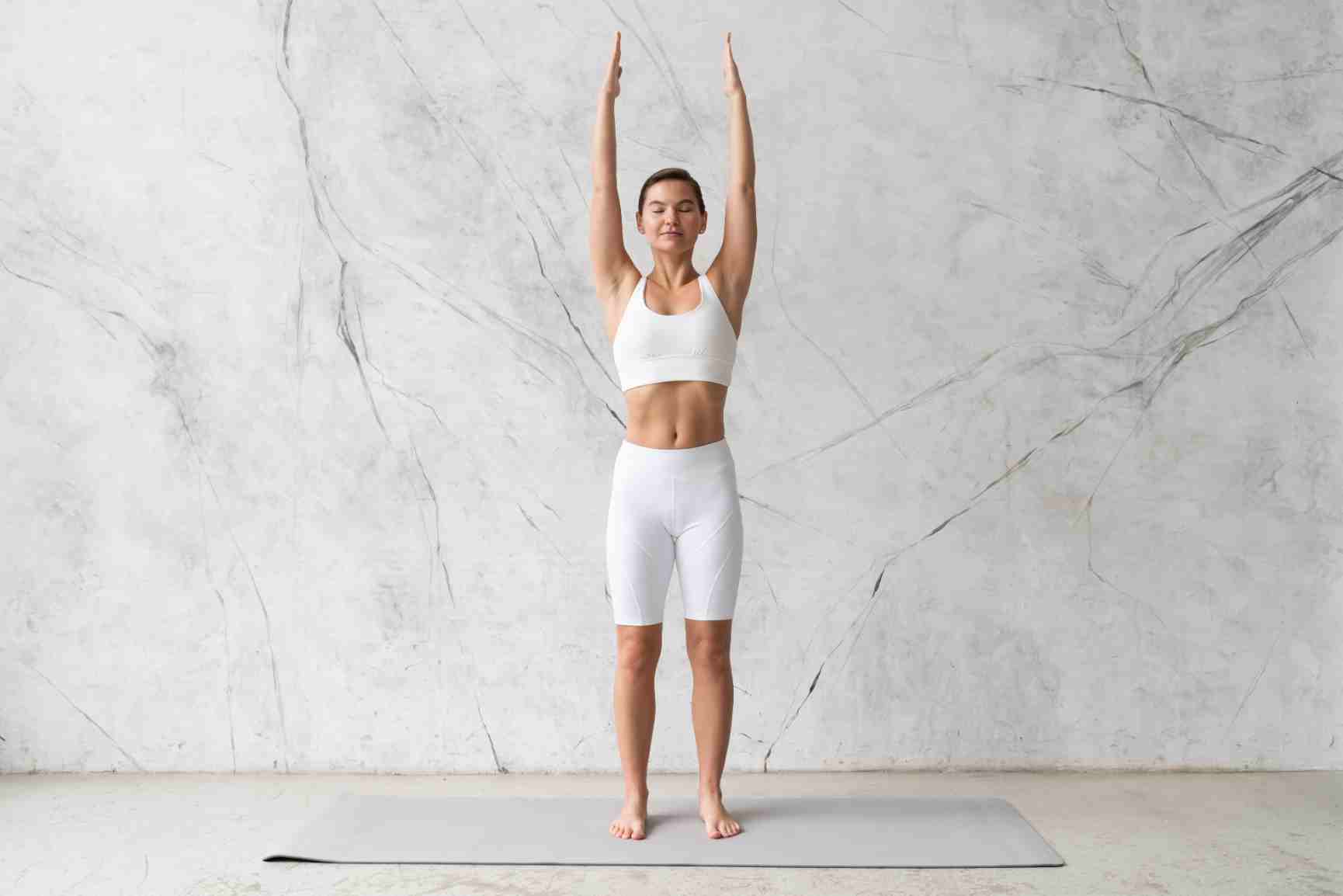
This pose involves arching your back and bending backwards. Here’s how to achieve this pose!
Step 1: Inhale and elongate your body.
Step 2: Stretch your hands up and bend backwards.
You should feel the stretch in your body as you keep your knees to the ground and arms stretched towards the ceiling.
3. Hastapadasana (Hand to Foot Pose)
After the Raised Arms Pose, it is time to perform the Hand to Foot Pose.
Step 1: Exhale and bend down from your waist.
Step 2: Keep your back straight.
Step 3: Touch the floor with your palms.
4. Ashwa Sanchalanasana (Equestrian Pose)
Follow these steps to complete the next pose in the series.
Step 1: Inhale and push your left leg back to touch the ground with your left knee.
Step 2: Focus on pushing the pelvis to the floor while keeping your back straight. Look upwards.
Step 3: The right leg should be between your palms with the feet firmly placed on the floor.
5. Dandasana (Stick Pose)
The stick pose is also known as the plank pose, and it is responsible for strengthening your core.
Step 1: After the Equestrian Pose, you must bring your right leg back and place it hip-width apart.
Step 2: Keep the arms perpendicular and balance your body weight with them.
Step 3: Take deep breaths and maintain your hips and chest at a medium level, neither too high nor too low.
6. Ashtanga Namaskar (Salutation With Eight Body Parts)
Step 1: Continuing from the plank pose, exhale and bring your knees, chest, and forehead on the floor while the hips are pushed upwards.
Step 2: Stay in this pose and take deep breaths.
The highlight of this pose is that it helps you relieve anxiety while making the back muscles stronger.
7. Bhujangasana (Cobra Pose)
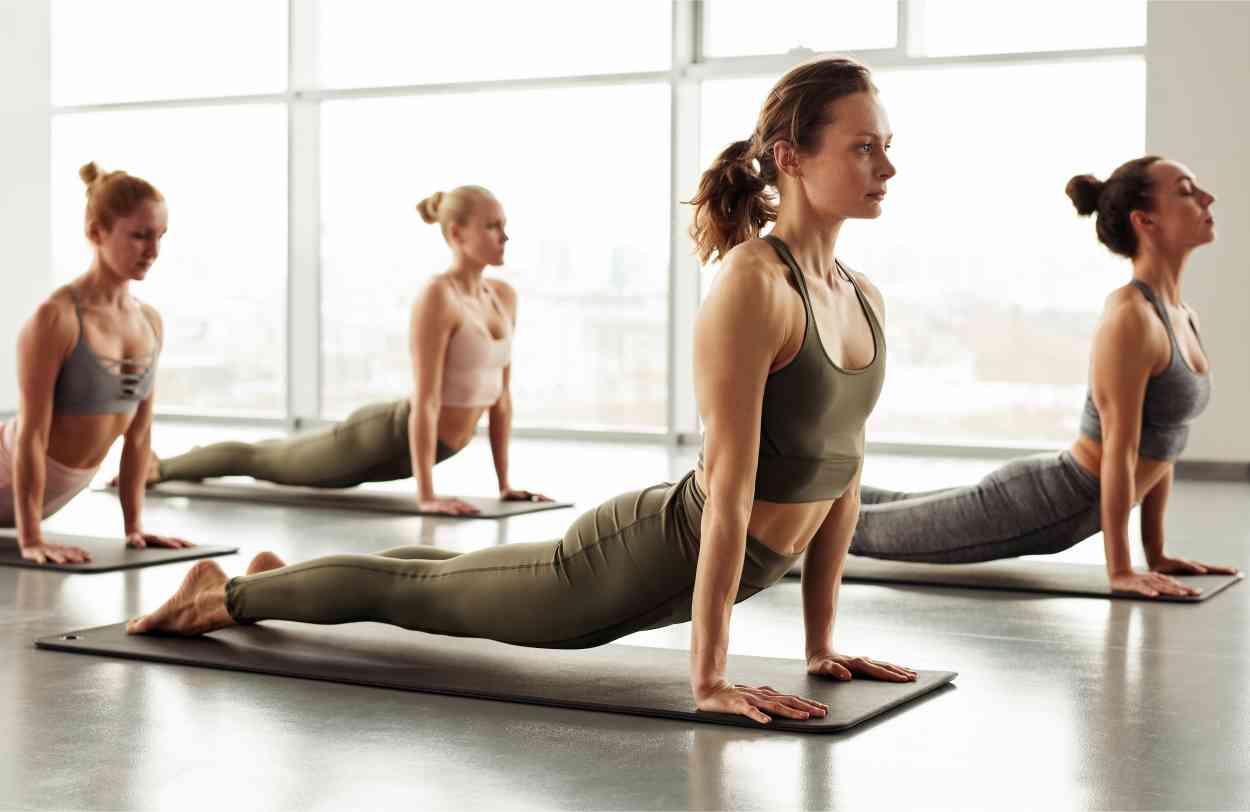
The next pose continues from pose 6.
Step 1: Inhale while raising your chest upwards and slide forwards.
Step 2: Keep your palms firmly pressed on the floor and your ribs inwards.
Step 3: Look upwards to prevent hurting your lower back.
Step 4: Push your chest outwards and the pelvis towards the floor.
8. Adho Mukha Svanasana (Downward-Facing Dog)
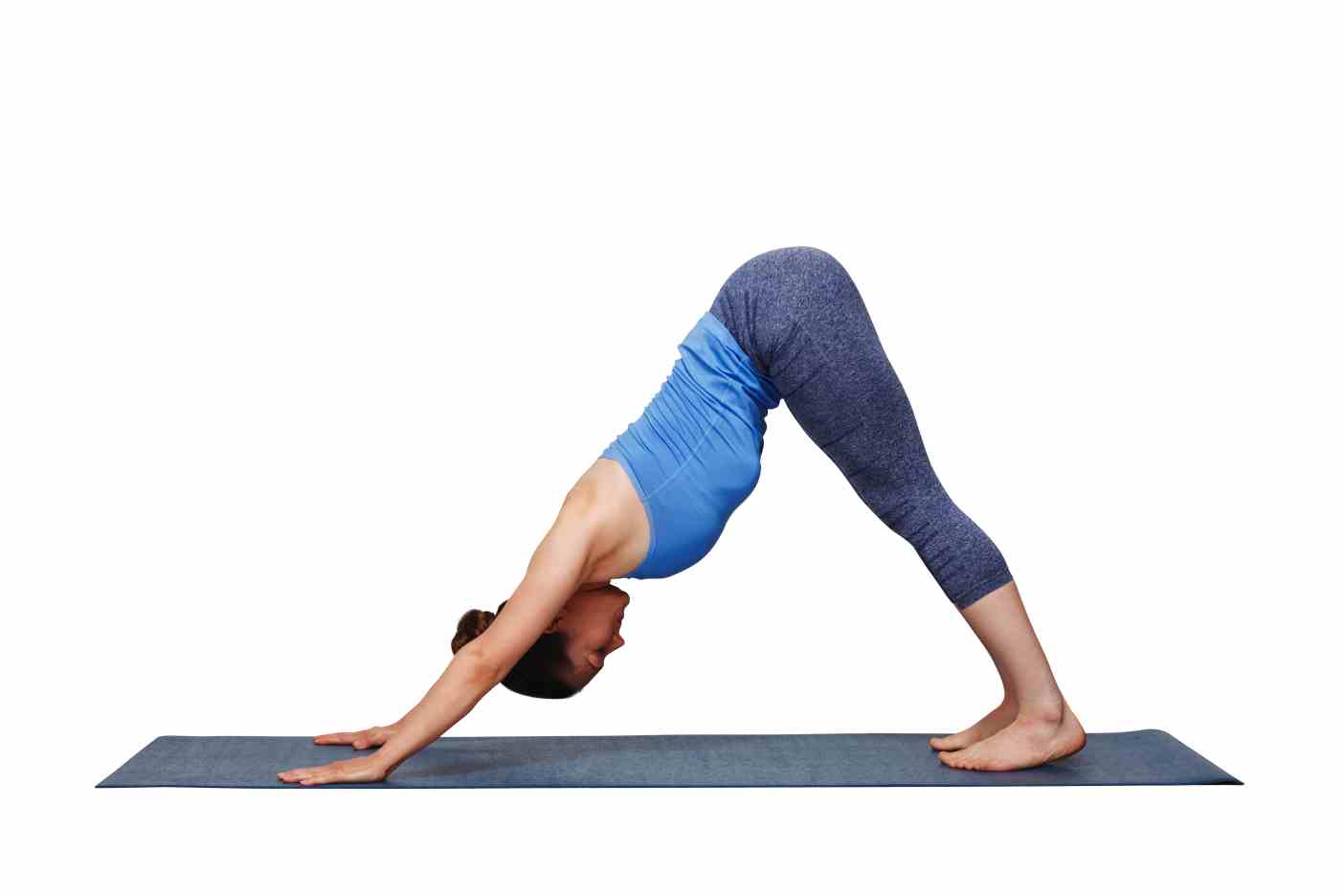
Kicking off from the cobra pose, get into the downward-facing dog.
Step 1: Exhale and lift your hips and waist.
Step 2: Keep hands and feet firmly fixed to the floor.
Step 3: The body should form a triangle.
Step 4: Keep your back straight and bend the knees a little in case you should feel a pull in the hamstring.
9. Ashwa Sanchalanasana (Equestrian Pose)
It’s time to go back to the equestrian pose from the downward-facing dog.
Step 1: Inhale and return to the equestrian pose. This time, however, use your right leg.
Step 2: Bend from the previous pose and bring your legs in between your palms.
Step 3: Keep your right knee on the floor.
Step 4: Keep your left leg perpendicular to the floor.
10. Hastapadasana (Hand to Foot Pose)

Now we’re back to pose 3. Here’s how to switch this pose from the Equestrian Pose.
Step 1: Exhale and bring your right leg back to the front.
Step 2: Keep both your legs straight and your back bent.
Step 3: Relax your body as this helps to maintain adequate blood flow.
11. Tadasana (Standing or Palm Tree Pose)
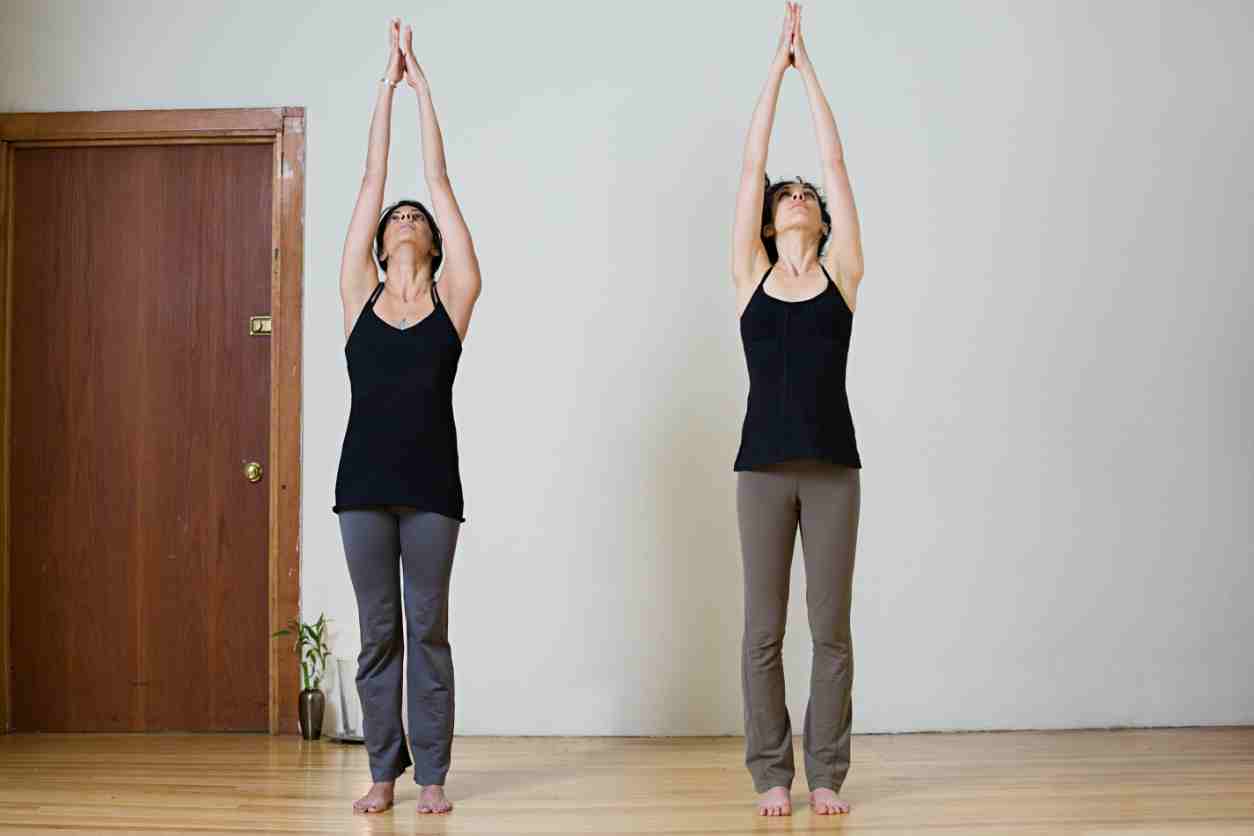
Finally, we’re at the 12th and simplest pose of the Surya Namaskar.
Step 1: Bring your hands down and exhale.
Sivananda Surya Namaskar
Sivananda Suryanamaskar is similar to Hatha Surya Namaskar. Here also, 12 poses are done at a medium pace. Hence, beginners prefer this type of Surya Namaskar.
Ashtanga Surya Namaskar
This Suryanamaskar for weight loss is completely different from the Hatha Surya Namaskar. It is more fast-paced and is divided into 2 stages, Type A and Type B. Moreover, this type emphasises the synchronised breathing between the poses called Vinyasa.
Type A
The 10 poses of Surya Namaskar are:
1. Samasthiti (Tadasana)
2. Raised Hands Pose (Urdhva Hastasana)
3. Standing Forward Bend (Uttanasana)
4. Half Standing Forward Bend (ArdhaUttanasana)
5.Four-Limbed Staff Pose (ChaturangaDandasana)
6. Upward Facing Dog (UrdhvaMukhaSvanasana)
7. Downward Facing Dog (AdhoMukhaSvanasana)
8. Standing Forward Bend (Uttanasana)
9. Raised Hands Pose (UrdhvaHastasana)
10. Samasthiti (Tadasana)
Type B
There are 19 poses in this sequence. They are:
1. Samasthiti (Tadasana)
2. Chair Pose (Utkatasana)
3. Standing Forward Bend (Uttanasana)
4. Half Forward Bend (ArdhaUttanasana)
5. Four Limbed Staff Pose (ChaturangaDandasana)
6. Upward Facing Dog (UrdhvaMukhaSvanasana)
7. Downward Facing Dog (AdhoMukhaSvanasana)
8. Warrior I (Virabhadrasana I)
9. Four Limbed Staff Pose (ChaturangaDandasana)
10. Upward Facing Dog (UrdhvaMukhaSvanasana)
11. Downward Facing Dog (AdhoMukhaSvanasana)
12. Warrior I (Virabhadrasana I)
13. Four Limbed Staff Pose (ChaturangaDandasana)
14. Upward Facing Dog (UrdhvaMukhaSvanasana)
15. Downward Facing Dog (AdhoMukhaSvanasana)
16. Half Forward Bend (ArdhaUttanasana)
17. Standing Forward Bend (Uttanasana)
18. Chair Pose (Utkatasana)
19. Mountain Pose (Samasthiti or Tadasana)
Iyengar Surya Namaskar
The sequence of Iyengar Surya Namaskar is similar to the Hatha sequence. However, it is more fast-paced with swifter transitions. Here also, there are 12 poses.
- Tadasana (Mountain Pose)
- UrdhvaHastasana (Upward Hand Pose)
- Uttanasana (Standing Forward Bend)
- ArdhaUttanasana (Half Standing Forward Bend)
- UttithaChaturangaDandasana (High Plank Pose)
- ChaturangaDandasana (Four-Limbed Staff Pose)
- UrdhvaMukhaSvanasana (Upward-Facing Dog)
- AdhoMukhaSvanasana (Downward-Facing Dog Pose)
- ArdhaUttanasana (Half Standing Forward Bend)
- Uttanasana (Standing Forward Bend
- UrdhvaHastasana (Upward Hand Pose)
- Tadasana (Mountain Pose)
Benefits of Suryanamaskar for Weight Loss
Here are the Suryanamaskar benefits for weight loss:
1. Boosts Metabolism
Practising Suryanamaskar regularly stimulates metabolic activity, helping to increase the body's calorie-burning capacity. This boost in metabolism contributes to effective weight management by accelerating fat loss even during rest periods.
2. Enhances Cardiovascular Health
Engaging in Suryanamaskar involves a series of dynamic postures that elevate the heart rate, promoting cardiovascular fitness. This improvement in heart health supports overall endurance and aids in sustained weight loss.
3. Improves Flexibility and Balance
The diverse range of movements in Suryanamaskar stretches and strengthens various muscle groups, enhancing flexibility and balance. Improved flexibility helps you perform daily activities easily and reduces the risk of injuries.
4. Tones and Strengthens Muscles
Suryanamaskar targets multiple muscle groups, including the core, arms, legs, and back. Regular practice helps ton and strengthen these muscles, contributing to a leaner and more defined physique.
5. Supports Detoxification
The coordinated breathwork and physical activity in Suryanamaskar enhance blood circulation and stimulate lymphatic drainage, promoting detoxification. This cleansing effect helps flush out toxins, promoting a healthier metabolism and weight loss.
6. Reduces Stress and Anxiety
Suryanamaskar incorporates mindful breathing and movement, which aids in reducing stress and anxiety levels. Lower stress levels can positively influence eating habits and weight management by reducing emotional eating and improving overall mental well-being.
7. Improves Digestive Health
The various poses and bends in Suryanamaskar massage the abdominal organs, enhancing digestive function. Improved digestion aids in better nutrient absorption and waste elimination, supporting a healthy weight.
8. Enhances Sleep Quality
Regular practice of Suryanamaskar has been shown to improve sleep patterns and quality. Better sleep contributes to a healthier metabolism and can aid in weight loss by reducing cravings and supporting hormonal balance.
9. Elevates Energy Levels
Suryanamaskar invigorates the body and mind, boosting energy levels. Increased energy can lead to higher levels of physical activity throughout the day, contributing to greater calorie expenditure and weight loss.
10. Promotes Hormonal Balance
The holistic nature of Suryanamaskar helps balance hormones, which is crucial for weight regulation. Hormonal balance can mitigate weight gain and support efforts to achieve a healthy body composition.
11. Supports Respiratory Health
Through the emphasis on controlled breathing, Suryanamaskar improves lung capacity and respiratory function. Enhanced respiratory health can increase stamina and support sustained physical activity, aiding in weight loss.
Body Parts & Muscles Impacted by Suryanamaskar Exercise
Suryanamaskar exercises engage many body parts and muscles, promoting overall strength and flexibility. Each pose targets specific muscle groups, from the arms and legs to the core and back, enhancing tone and endurance. Below is a table summarising the main body parts and muscles impacted by Suryanamaskar:
Body Part |
Muscles Targeted |
| Arms | Biceps, triceps, deltoids |
| Legs | Quadriceps, hamstrings, calves |
| Core | Abdominals, obliques, lower back |
| Back | Latissimus dorsi, erector spinae |
| Chest | Pectoralis major, minor |
| Shoulders | Deltoids, trapezius |
| Hips | Gluteus maximus, medius |
| Spine | Spinal erectors, intercostals |
| Neck | Sternocleidomastoid, scalenes |
How Long Should You Do Suryanamskar to Lose Weight?
For optimal weight loss results with Suryanamaskar, it's recommended to dedicate at least 20 to 30 minutes daily to practice. This duration allows for approximately 12 to 15 rounds of Suryanamaskar, ensuring adequate calorie expenditure and muscle engagement. Consistency in this routine is essential for sustained weight loss benefits over time.
However, it's important to listen to your body and gradually increase the duration and intensity of your practice as your fitness level improves.
How Many Calories are Burned in Suryanamaskar?
The number of calories burned during Suryanamaskar varies based on weight and intensity. For an individual weighing 70 kilograms, a 30-minute session typically burns around 150 to 200 calories. However, this estimation may fluctuate depending on metabolic rate and exertion level. Regular Suryanamaskar practice can contribute significantly to calorie expenditure and aid in weight management.
Maintaining proper form and intensity is important to maximise calorie burn while avoiding injury. Consistency in practice and complementing it with a balanced diet can enhance weight loss outcomes over time.
What Time of the Day is Better for Suryanamaskar to Lose Weight?
The optimal time for Suryanamaskar to aid in weight loss is typically in the early morning, preferably at sunrise. Performing Suryanamaskar in the morning helps kickstart metabolism and energise the body for the day ahead. Additionally, the morning's fresh air and quiet atmosphere can enhance focus and concentration during the practice.
However, choosing a time that aligns with your schedule and allows for consistency in practice is essential. Whether in the morning or another time of day, maintaining a regular practice routine is key to maximising the weight loss benefits of Suryanamaskar.
What to Avoid When Doing Suryanamaskar?
To ensure a safe and effective Suryanamaskar practice, it's essential to avoid common mistakes and maintain proper form:
Avoid rushing through the poses; maintain a steady and controlled pace.
Do not hold your breath; remember to breathe deeply and rhythmically throughout the practice.
Avoid overextending or forcing your body into poses beyond its limits to prevent injury.
Do not strain your neck or shoulders; keep them relaxed and aligned with the spine.
Avoid overarching or rounding your back excessively; aim for a neutral spine position.
Refrain from skipping warm-up stretches; perform gentle stretches to prepare the body for the practice session.
Techniques for Effective Suryanamaskar
Mastering Suryanamaskar, or Sun Salutation, is key for effective weight loss through yoga. Here are essential techniques:
- Align Correctly: Maintain proper posture and distribute weight evenly.
- Sync Breath and Movement: Inhale deeply for expansion, exhale fully for contraction.
- Engage Core: Activate abdominal muscles for stability and strength.
- Transition Smoothly: Move seamlessly between poses to enhance flexibility.
- Breathe Mindfully: Stay aware of your breath to deepen poses and relax.
- Modify Poses: Adjust according to your fitness level and flexibility.
How to Add Suryanamaskar to Your Workout Program?
Integrating Suryanamaskar into your fitness routine can enhance flexibility, strength, and overall well-being. Follow these steps to incorporate Suryanamaskar into your workout program seamlessly:
- Set Clear Intentions: Determine your goals and intentions for incorporating Suryanamaskar into your routine, whether for weight loss, stress reduction, or spiritual growth.
- Start Slow: Begin with a few rounds of Suryanamaskar, gradually increasing the number of rounds as you build strength and endurance.
- Schedule Regular Sessions: Allocate specific times in your weekly schedule for Suryanamaskar practice, treating it as a dedicated workout session.
- Combine with Other Exercises: Pair Suryanamaskar with complementary exercises such as strength training, cardio, or other yoga poses to create a balanced workout routine.
- Listen to Your Body: Pay attention to how your body responds to Suryanamaskar practice, modifying poses or intensity as needed to prevent injury and promote progress.
Who Should Avoid Doing Suryanamaskar for Weight Loss?
While Suryanamaskar has been shown to aid in losing weight, some should avoid doing the same. These include –
- Women with over 3 months of pregnancy.
- Individuals with a hernia, high blood pressure, and back conditions.
- Menstruating women.
The benefits of Suryanamaskar for weight loss are manifold when done repeatedly in sets. Moreover, you will also need to hold the pose as directed to lose weight effectively.
Disclaimer: Before starting with any of the Suryanamaskar poses, consult a qualified yoga professional to avoid any injury.
Overall, Suryanamaskar offers a comprehensive approach to weight loss by burning calories, improving muscle tone, and enhancing metabolism. Beyond its physical benefits, it also helps reduce stress, boost mental clarity, and support overall health. As a versatile exercise, Suryanamaskar integrates seamlessly into daily routines, making it an effective practice for achieving sustainable weight loss and a balanced lifestyle.







